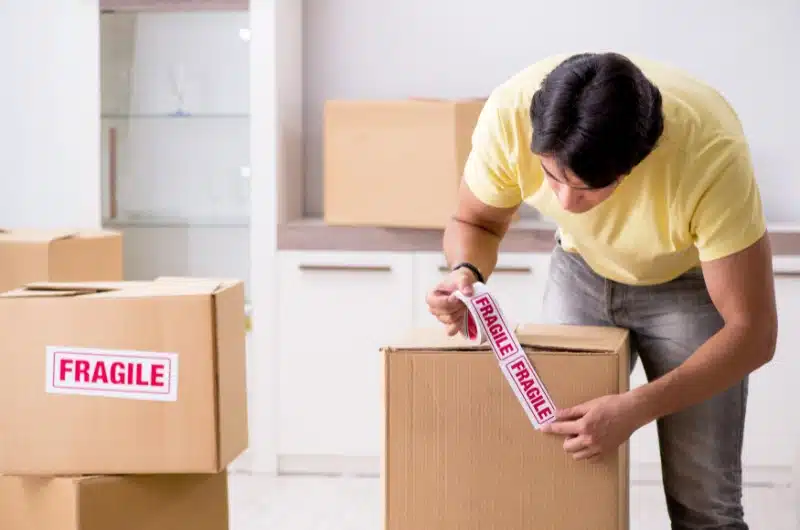
Prefer not to leave your phone number?
No problem!
Schedule an Appointment at your Convenience
(Only email is required)
Schedule an AppointmentOr Call / Text
800-333-3434By: Last Updated: Apr 11, 2024
Protect your delicate treasures by carefully cushioning, wrapping, and labeling each one. By using the best packing methods detailed in this article, you can rest assured your items will reach their destination safely.

Moving across the country is an exciting experience, but it’s not without its fair share of nerves, especially when it comes to moving and securing fragile items. Whether it’s a cherished family heirloom or a delicate glass gift from your anniversary, we want to make sure these items arrive safe and sound to your new destination.
So, let’s get into some smart packing strategies to safeguard your delicate treasures.
When it comes to packing and moving fragile items, careful planning and a strategic approach are what you need. It’s all about using the right materials, wrapping each item properly, and ensuring they’re securely packed. Starting your preparations well in advance of moving day is necessary.
If you’re short on time or want to avoid the stress, you should enlist professional cross-country movers. They bring expertise in handling delicate items and offer extra protection, using premium packing materials specifically suited for fragile belongings. With their help, you can rest easy knowing your items are in safe hands.
To ensure your belongings arrive damage-free, it’s essential to stock up on the right packing supplies.
Here’s a detailed list of what you’ll need:
If supplies are tight, get creative with household items like towels or scarves for extra padding. Anything that can protect delicate items can be used.
When sorting your fragile items, pick a quiet, spacious area to sort them by factors like fragility, size, and importance. This approach helps you protect your most treasured pieces effectively.
Whether you’re sorting by material, function, or how they fit together, patience is key to minimizing damage and ensuring everything arrives intact. Consider separating particularly delicate items like ceramics and glassware to avoid damage from rubbing together.
While taking on the task yourself can save money, hiring professional movers offers unmatched expertise in safely handling your valuables, which eliminates the worry of accidents caused by inexperience.
Choosing the right boxes is crucial for protecting your fragile items. Purchase new, heavy-duty corrugated cardboard boxes designed with a multi-layer construction. They’re great for absorbing shocks and impacts. Select boxes that fit the specific needs of your sorted items to ensure they’re snug and secure.
Avoid the temptation of settling for cheaper, weaker boxes; their lack of durability could result in damage, ultimately costing you more. Although they’re pricier, specialized boxes offer the structural strength needed to prevent overpacking or underpacking, which minimizes the risk of your items shifting and breaking during transit.
Wrapping each item with care is essential for the safe transport of your fragile belongings. Individually wrap pieces in packaging paper or old newspaper, especially the most delicate items like fine china and glassware.
Use bubble wrap or packing peanuts to create a strong barrier against bumps and shocks during the move. Secure everything with packing tape to ensure a tight hold. This will help to maintain the integrity of each item.
When packing fragile dishes or ceramics, using dividers and padding is a game-changer. Cardboard dividers help organize items within sturdy, purpose-built boxes, offering each piece its own cushioned space. Fill any gaps with crumpled packing paper and bubble wrap to prevent movement and act as shock absorbers.
Combining dividers with padding forms a shield unlike any other, safeguarding your fragile belongings against the bumps and jostles of a cross-country move.
This approach ensures every delicate item is securely packed and ready for the journey.
The layering technique is a cornerstone of effective packing. Start with a base layer of packaging peanuts in the box for a sturdy foundation, ensuring the distribution of weight is optimal. Heavy items go at the bottom, with lighter, more fragile items on top.
The true genius of layering unfolds as crumpled paper between layers acts as a shield, buffering and isolating your items from vibrations during transit. This method not only protects but also organizes your belongings efficiently for the journey ahead.
Labeling plays a crucial role in ensuring the safe handling of your items during packing and unpacking. Use stickers, markers, or colored labels to clearly mark boxes with “FRAGILE,” “HANDLE WITH CARE,” or any specific instructions you want. This written communication is key, alerting anyone involved in the move to treat these boxes with extra care.
Labeling boxes based on the weight of their contents prevents heavier items from crushing lighter, delicate ones. This simple step acts as an essential guide for both packers and movers, minimizing the risk of damage.
Securely sealing your boxes is crucial for the safe move of fragile items, requiring a robust seal that acts as a barrier, holding everything tightly together. Pay extra attention to reinforcing the base and edges.
On the other hand, hiring professional movers can significantly ease the stress of moving delicate items across long distances. With their expertise, tools, and experience, they can handle the packing process efficiently, allowing you to step back and focus on other aspects of your move with peace of mind. Combining secure packing with professional assistance offers the best protection for your valuables and a smoother moving experience.
Insurance is a must-have for protecting your fragile and valuable items during a move. It’s a small but critical investment that can ease your mind from the stress and concerns of moving. We would highly suggest buying extra insurance on top of the basic coverage to protect the compensation of your most valuable belongings.
Take care when loading your items, and oversee the process if you can. Ensure that boxes with fragile contents are placed in a secure and reachable spot, well away from heavier boxes.
For the best protection, position them on top of the heavier loads to keep them safe and easily accessible.
No matter how tedious or boring a task might be, do not skip it. It’s important to secure your belongings tightly and securely, so they don’t break in transit.
Trust the process, don’t rush it.
Use sturdy cardboard boxes, bubble wrap, packing paper, foam peanuts, for the best protection.
Mark “FRAGILE” or “HANDLE WITH CARE” on all sides of the boxes.
Use cushioning material and dividers. Pack fragile boxes on top of heaving ones.
Opt for additional coverage beyond just the basic insurance the moving company gives out. Look at plans that cover the value of the item.
And there you have it, your complete guide to packing fragile items like a pro for cross-country moves. With the right materials in hand, a strategic approach to packing, and knowing the importance of taking your time, you’re set to tackle this head-on.
Remember, the secret to a seamless move lies in the planning and execution. So, take a deep breath, roll up your sleeves, and put all these tips into action. Your fragile items are counting on you to get them to safety!